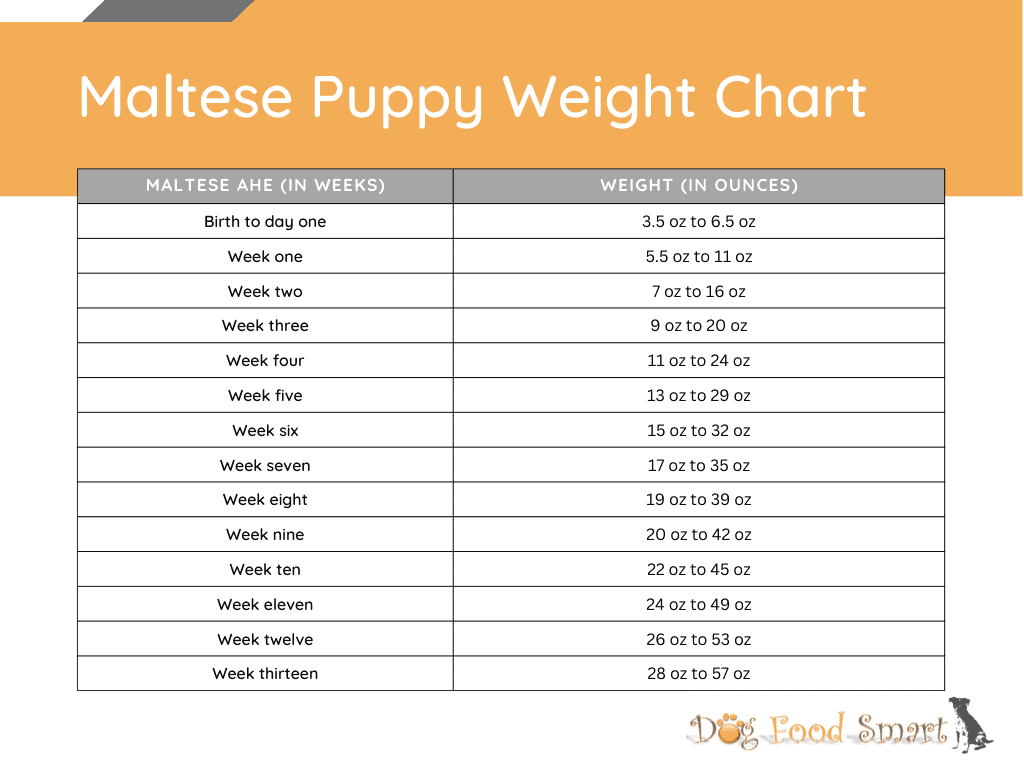Maltese Growth Chart – Weight & Size Chart
The Maltese dog is tiny and known for its long luxurious coat. These playful, adaptable, and charming toy dogs are great companions.
Having a Maltese growth chart will it be able to help you track their development as they grow. Underneath a Maltese’s show-stopping coat is a compact frame that gives them an effortless and smooth gait.
They are ancient dogs with gumdrop noses and dark eyes. Many people fail to resist their buoyant charm. Furthermore, they fit in well with the family because they are loyal and intelligent. Maltese’s are also low shedders and take up only a small space because of their size.
They also come in handy when it comes to security since they are alert and will bark at intruders. Combined with their agility and long lifespan, this breed is special indeed.
When Does the Maltese Stop Growing?

Your Maltese dog would have reached his full size by his first birthday. In fact, you probably would have noticed that he had to stop growing by at least three months before this.
However, there are a few rare instances where a Maltese dog continues to grow until they are about 15 months old.
It’s also important to consider that Maltese dogs tend to vary in size, which is most likely a genetic trait. Therefore, the parents of your Maltese pup will affect his size in adulthood.
The male Maltese tend to be larger than females, but they can weigh between 4 and 7 pounds in adulthood.
Maltese Weight Chart
The Maltese weight chart below gives an average size of your Maltese dog’s weight. There are some instances where the weight may be higher or lower than what appears in the Maltese growth chart. In most cases, this is no cause for serious alarm.
You should note, however, that if you find your Maltese puppy’s weight is much lower than any of the numbers stated, you should assess his health.
Your Maltese may be too small and have a greater chance of developing several health problems.
On the other hand, if your Maltese puppy’s weight is higher than any of the numbers stated, you should not panic.
Although your Maltese dog may not fall within the perfect range (preferred adult weight is 4-6 pounds), having a few extra pounds over average is fine.
Even though it is not common, some Maltese dogs can grow to 9 pounds and still be healthy. Just ensure that you provide regular check-ups. You can feel free to use this Maltese size chart as a guide and not a standard rule.
Maltese Puppy Weight Chart
This Maltese growth chart can help you estimate the size of your Maltese. If your pup falls within the weight range below for the age, then he is most likely within a healthy weight range.


What Is The Average Weight For A Maltese?
The average weight for a Maltese adult is going to be between 3.5 and 7 pounds. But you must remember that every dog is different, and your Maltese could be weighing in at a higher or lower weight, depending on other factors we cover in this article.
It is unusual for a Maltese to get any bigger than seven pounds. If he is, he may be a mixed breed or severely overweight.
Your veterinarian can help you calculate your dog’s body condition score to see if they are within a healthy weight range for their age.
Maltese Growth Chart – What To Expect
Birth – 2 Weeks
Maltese pups are born deaf, toothless, and blind. This is a sensitive stage because they cannot regulate their body temperature. During this period, the newborn puppy relies on its mother and siblings for warmth and comfort.
They can wiggle and crawl close to their mother, but their muscles and coordination do not allow them to walk just yet.
Owners need to allow the puppies to have this time with their mothers so that they may properly develop.
3 Weeks – 12 Weeks
At this time, you will find that your Maltese puppy has undergone many changes. For instance, they are much more mobile as their muscles start to develop. So you have cute puppies who are playfully exploring and romping around with their littermates.
Weaning also starts during this time, and from around the end of week 4 to the start of week 5, the dam will nurse less. The pup should now be weaned onto solid foods.
By the 7-week mark, the pup will be fully weaned and eating solid food. The milk teeth start to come in at around week 8.
4 Months – 6 Months
During this period, the Maltese pup will go through teething. The 28 milk teeth will start to fall out, and then 42 adult teeth will come in as their replacement. At this stage, you should also be on the lookout for tear and face staining.
This can be a big problem for most Maltese owners. You should expect tear and face staining to begin when your puppy is four to five months old.
Some people treat tear staining with hydrogen peroxide, but it is always advised to visit your vet.
7 Months – 9 Months
During this time, most Maltese dogs experience puberty for the first time. The female dogs have their first heat cycle, and the males are now producing viable sperm.
You need to keep an eye on them because they have been known to stray at these times in pursuit of mates.
10 Months – 12 Months
For some pups, you may notice a cessation in growth while others keep growing. Most puppies will continue to mature until about nine months old, but they can also grow through the one-year mark. The growth curve will tail off quickly after about 6 months.
Adult
The common size of adult Maltese dogs is approximately 7 pounds. Maltese dogs may range from 3 to 8 lbs.
They should have a short height and a very small stature as well, with an average height of 8 to 10 inches, measured from floor to withers (shoulder blades).
How Big Do Maltese Get?

As the dog owner of a Maltese puppy, you may go in with the expectation that you have a small puppy. But precisely what size will they be when they are fully developed? Many people would like to know the eventual size of their Maltese.
There are a few ways that you can figure this out. Firstly you should know that you have come to the right place. Because you can refer to the growth chart within this article to get a better idea of the adult size of your Maltese
Additionally, you can look at the parents of your Maltese puppy. Communicate with your breeder to find out his parent’s size.
Breeders usually record this information, and you can estimate that your puppy will be the average size of both parents.
Many people also look at their dog’s paws to estimate the amount of growth left because if a dog’s paws are bigger in proportion to the rest of his body, he has more growing to do.
DNA tests are also helpful because they can pinpoint the precise genealogy of your dog so that you can be aware of any mixing in his ancestry.
Will Neutering/Spaying Affect My Maltese Growth?
The most ideal time to have your Maltese dog neutered or spayed is when they have reached 18 months old.
Keep in mind that a Maltese usually reaches adulthood between the ages of 12 to 15 months. So this would give them enough time to fully develop before spaying or neutering takes place.
Research has shown that neutering, in particular, can negatively affect the growth of a male dog. This is because the testosterone in their bodies affects growth. When you neuter them, it affects this process causing issues with their joints as well as certain cancers.
That said, there are also a few benefits to spaying and neutering, such as preventing unwanted pregnancies. It can also prevent certain diseases and help to make your dog less aggressive in some cases.
Maltese Size Chart
According to the American Kennel Club (AKC), The Maltese stand at around 7 to 9 inches when they become full-grown adults. They usually weigh under 7 lbs.
We usually measure the height of dogs by using the withers, which are the highest points of their shoulder blades.
To measure your Maltese dog, simply use a measuring tape that goes from the floor to his withers in a straight line. This measurement is your dog’s height.
How To Properly Weigh And Measure A Maltese

Tracking your dog’s weight throughout his development is a good way to assess his health. The Maltese are a toy breed, so it may be easy for you to place him on a bathroom scale.
But when he reaches adulthood, it may not be that easy. Also, the issue is having him stay still while you record his weight.
To get around this, you need to hold him while you are on the scale. All you have to do is measure your weight and then measure the weight of both you and your Maltese while holding him on the scale.
The weight of your Maltese will be the difference between these two measurements.
What Dog Food Should You Feed a Maltese to Keep Them Healthy?
The best dog food for your Maltese is a naturally balanced formula specially formulated for small breed dogs. The dog food should focus on maintaining your pup’s digestive system while improving his skin and coat health.
How Do You Know If A Maltese Is Overweight?
As we already mentioned, a Maltese over 7 to 8 pounds will be considered overweight because they are such a small dog breed. If your pup is at a healthy weight, you should have no problem feeling their ribs. They will have a thin layer of fat covering them.
However, if your Maltese is overweight, you won’t be able to feel their ribs because the excess fat is thicker padding. You also want to feel around for the hip contours. There should be a small depression between the hips and the ribs, signifying they are a healthy weight.
Bichon vs Maltese Size
Even though the Bichon and the Maltese are small dogs, the Bichon is a bit larger than the Maltese. When the Maltese have reached adulthood, they are around 3 kg, while the Bichon Frise weighs around 3-5 kilograms.
The male Maltese stand at 20 to 25 centimeters while females stand at 20 to 22 centimeters. On the other hand, Bichon Frise males and females run a bit taller, with 22 to 27 centimeters.
Maltese Body Shape Change
Newborn puppies gain weight each day after their birth. But each Maltese puppy grows at its own pace; this depends on various factors like nutrition, genetics, and activity level.
It is not uncommon for two 3-month-old Maltese puppies to have different weights (for example, 2.5 lbs. and 4 lbs.), but both still have a weight of 6.5 pounds in adults.

Most of the growth will happen in the first 6 months after birth. For the rest of the first year, there may be small adjustments in weight, height, or both.
Maltese dogs tend to be proportionate, with the height measurement from the top of the shoulders to the ground the same measurement as from the top of the shoulder to the tail root.
Factors That Affect Maltese Puppy Growth
Genetics
Hereditary factors have the most impact when it comes to a Maltese puppy’s growth. These genetic factors control the growth rate and other important factors that add to their development.
Nutrition
The food you give to your Maltese puppy will affect his ability to grow. If you constantly give your puppy low-quality food without the proper nutrients he needs to grow, then his development will be impeded.
There are low-quality foods that will not offer enough nutrients as they will be full of fillers that have little or no nutrients needed by a growing puppy. They cause stunting of growth in dogs.
Physical Activity & Health
Sufficient exercise is needed to stimulate growth and develop bone density. Stronger bones and a fitter body will add weight to your puppy while keeping him healthy.
Your Maltese dog will have healthy, strong muscles when he is allowed to exercise regularly. Exercise will also work off any extra calories if your puppy overeats occasionally.
How Much Food Should a Maltese Eat Daily?
A Maltese between two and four pounds should be eating approximately ¼ cup to ½ a cup each day. A Maltese weighing over five pounds will eat between ½ a cup and ¾ cups of dog food per day.
When feeding your Maltese pup, avoid fillers, artificial additives, generic meat sources, and by-products, as these can prove harmful to your dog.
How Long Are Maltese Pregnant?
As with other small dog breeds, a Maltese pregnancy lasts roughly 8 to 10 weeks.
After about 8 weeks, the Maltese litter could be expected at any time. It should be a cause for concern if a Maltese pregnancy is prolonged after 10 weeks.
Ordinarily, it may be possible for Maltese dogs to get pregnant as soon as they have their first heat cycle. This usually occurs in the 4- to 8 months period, which is very young.
It is not advised for Maltese to get pregnant in their first heat cycle because their body has yet to fully develop, and it is harmful to them at this age.
How Many Puppies Do Maltese Have?
A Maltese can have between 3-8 puppies in the average pregnancy. Though it is rare, a single puppy will be born every so often, or a larger litter of 10 can be born, too.
It is important to note that Mom’s age, size, and other health factors can affect the number of puppies.

Maltese puppies are very cute and tiny when there are born. It is advised not to allow very small children to handle them when they are young and fragile.
Maltese puppies tend to weigh around 4 ounces when they’re born and steadily gain weight every single day as they gain strength and develop.
What If My Maltese Is Not The Right Weight
Most Maltese owners want to know how big the pup will be as he develops and what size he will be as an adult dog. With Maltese dogs, however, rates of growth can differ quite a bit.
Some owners fear their Maltese puppy is not gaining weight as he should. It is important to remember that with an end goal of just 3 to 6 or 7 pounds, there is not that much growing to do.
Some Maltese dogs will have a somewhat larger bone structure, so a pound or so over that 7 lb. limit is not uncommon and is no cause for alarm.
On the other hand, if a Maltese puppy is always on the low end of the scale, he will most probably end up being 3 to 4 lbs.
When Maltese pups have a consistently low weight, you don’t need to be alarmed but ensure that he is receiving proper nutrition and always visit your vet.
What Is The Life Expectancy Of Maltese?
Approximately 12 to 15 years is the usual range for life expectancy for the Maltese dog breed, with 13 and a half years old being the average age of natural death.
Some Maltese dogs live much longer lives, even though this is the normal age of death. They can reach 15, 16, and even 17 years old, with females living a bit longer than males.

Since the average canine lives approximately 12 years, the Maltese breed tends to live a bit longer than dogs on average. A Maltese dog is said to be in his prime between the ages of 1 and 8. After this, they start to decline.
How Much Does It Cost To Own A Maltese?
To own a Maltese dog, the average cost is about $1000 to $3000 annually. This would cover all the expenses, such as food, training, vet visits, toys, and vaccinations.
Because the Maltese are a smaller dog breed, the costs are actually less than a much larger dog. Larger dogs would require more food, more exercise, and better training.
Purchasing a dog is not a choice that should be made without proper consideration. It is good to have an in-depth understanding of the overall costs to maintain a Maltese each year so you can make an informed decision.
Maltese Genetics And Common Health Problems
Many of the health problems a Maltese experiences is largely due to genetics, while others are more environmental. Routine care is so important for maintaining your pup’s health and to help ensure they grow up to be healthy and happy overall.
Hypothyroidism
The Maltese pup is more prone to hypothyroidism than other dog breeds. With this condition, they can’t make enough of the thyroid hormone. You may begin to notice dry skin problems, some hair loss, weight gain, aggression, and other behavioral changes.
Patellar Luxation
Patellar luxation is another condition that can plague a small dog breed like the Maltese. It is when the kneecap slips out and becomes dislocated. It often happens within their first year and is primarily considered an inherited congenital disorder. However, it can also happen as a result of trauma or an injury.
Heart Disease
In their golden years, heart failure is a leading cause of death among Maltese dogs. A weakening of a valve is what causes heart disease in dogs in most cases.
A heart valve gradually becomes damaged so that it no longer closes tightly. Blood then leaks back around this valve and hurts the heart. Dogs with heart valve disease will have a heart murmur.
Liver Problems
The Maltese are more susceptible than other breeds to have a liver disorder called portosystemic shunt (PSS). This occurs when some of the blood supply that should go to the liver instead goes around it, causing it to function improperly.
If your dog has PSS, his liver cannot effectively remove toxins from his bloodstream. Unfortunately, this could be fatal.








